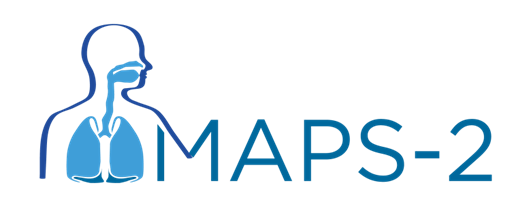| Title |
The Metoclopramide for Avoiding Pneumonia after Stroke (MAPS-2) trial:
a single-blind, randomised controlled trial of metoclopramide for the
prevention of pneumonia in patients with dysphagia after an acute
stroke.
|
| Acronym |
MAPS-2 |
| Short title |
Metoclopramide for Avoiding Pneumonia after Stroke |
| Chief investigator |
Christine Roffe |
| Objectives |
-
To assess whether metoclopramide reduces mortality in patients with
dysphagia after stroke
-
To assess whether metoclopramide reduces pneumonia and improves
neurological recovery at 14 days
-
To assess whether metoclopramide improves long-term outcomes
(6 months)
- To assess cost-effectiveness and cost-utility
|
| Trial configuration |
Two-arm parallel group single blind randomised controlled trial
(Flow Chart) with an internal pilot
|
| Setting |
Emergency departments and stroke units of 90 or more NHS hospitals
|
| Sample size estimate |
The sample size has been calculated to detect a 20% relative reduction
in mortality from 33% in the sham control group to 26.4% in the
metoclopramide group at 6 months (equivalent to hazard ratio = 0.7654)
with a power of 90%, using a two-sided log-rank test (Schoenfeld
method) with a significance level of 5%, and 1:1 allocation.
Assuming patients are followed-up to a maximum of 6 months, 588 deaths
need to be observed. This requires 1980 participants (990 per arm)
to be recruited. With 5% loss to follow-up, we aim to recruit
approximately 2,100 participants.
|
| Number of participants |
2100 |
| Eligibility criteria |
Inclusion criteria
-
Adults (at least 18 years old) with a clinical diagnosis of
acute stroke
- Within 24 hours of symptom onset
-
One of the two below criteria:
3a. Moderate to severe neurological impairment (NIHSS Score ≥ 10),
or
3b. Dysphagia and NIHSS ≥ 6, unable to take normal unmodified oral
diet or fluids because:
(a) Too drowsy to be assessed formally or
(b) Failed bedside assessment of swallowing
Exclusion criteria
- Definite or probable pneumonia at screening
- Contraindications to metoclopramide
- Clinical indication for regular antiemetic treatment
- Known cirrhosis of the liver
- Known severe renal dysfunction (eGFR < 30 ml/min)
- Pregnant or breast feeding
- Moribund (expected to die within the next 48 hours)
- Co-morbid conditions with life expectancy <3 months
- Inability to gain consent (patient or legal representative) or
consent declined
|
| Description of interventions |
Intervention: Metoclopramide solution for injection 10 mg/2 ml three
times a day by slow IV injection or via nasogastric tube. For
participants weighing less than 60 kg the dose will be reduced to 5
mg/1ml three times a day.
Control: Normal saline solution for injection (sham control) 2 ml three
times a day by slow intravenous injection or via nasogastric tube.
Intervention/control treatment will be continued for 14 days or until
discharge into the community, whichever is earlier.
|
| Duration of study |
Study start date 1 Oct 2021
Duration for each participant: 6 months
Study end date: 30 Apr 2025
|
| Randomisation and blinding |
Participants will be individually randomised 1:1 via a web-based
interface to metoclopramide or sham control by minimisation using
NIHSS, age, mRS, time from stroke onset, and type of trial centre as
factors. The trial will be single-blind (blinded assessment of
primary outcome).
|
| Outcome measures |
Primary outcome
All-cause mortality (time-to-event) by 6 months
Secondary outcomes at 14 days
- Pneumonia (clinician diagnosis)
- Pneumonia (criteria-based)
- No of days of antibiotic treatment
- Ability to swallow (DSRS)
- Neurological recovery (NIHSS Stroke Scale)
- Quality of life (EQ-5D 5L™
Secondary outcomes at 6 months
- Functional status (modified Rankin Scale)
- Ability to swallow (DSRS)
- Frailty (CFS)
- Home time (no. of days spent at home rather than in
hospital or care home)
- Quality of life (EQ-5D 5L™)
Health economic outcomes
- Cost per death avoided over 6 months
- Cost per QALY gained over 6 months
- Cost per QALY gained over patient lifetime
Safety outcomes to the end of treatment (14 days)
Oculogyric crises
Tardive dyskinesia
Adverse events
Discontinuations due to adverse events
|
| Statistical methods |
The primary analysis will compare time to death between the
metoclopramide and sham control, with analysis according to the
allocated treatment regardless of treatment received (intention to
treat). A Kaplan-Meier curve will compare the estimated survivor
functions between arms. A Cox proportional hazards model will be
used to calculate the hazard ratio and 95% confidence interval,
censoring participants who have not died by 6 months or who are lost
to follow-up. The model will be adjusted for the minimisation
factors. As a sensitivity analysis, we will repeat the primary
analysis by: (i) additionally adjusting for any variables with marked
imbalance at baseline and for post-randomisation factors that are
expected to affect outcome and (ii) treating the outcome as binary to
obtain between-arm adjusted risk difference and risk ratio along with
corresponding 95% confidence intervals. Should there be
substantial missing data we will perform sensitivity analysis using
imputation representing best and worst-case scenarios, to assess the
effect of possible informative censoring, and/or use appropriate
multiple imputation procedures for time-to-event data.
Non-adherence is likely to be minimal at primary follow-up point as
efforts will be made to maximise adherence with allocated treatment,
but a sensitivity analysis based on complier average causal effect
(CACE) will be performed to investigate the effects of adherence.
Between-group comparison of secondary outcomes will be based on an
appropriate regression model for the outcome (linear for continuous,
logistic for binary, and proportional hazards for time-to event),
adjusted for the same variables as the primary analysis. The
level of significance used for all statistical tests will be 5%,
two-tailed (p < 0.05).
|









